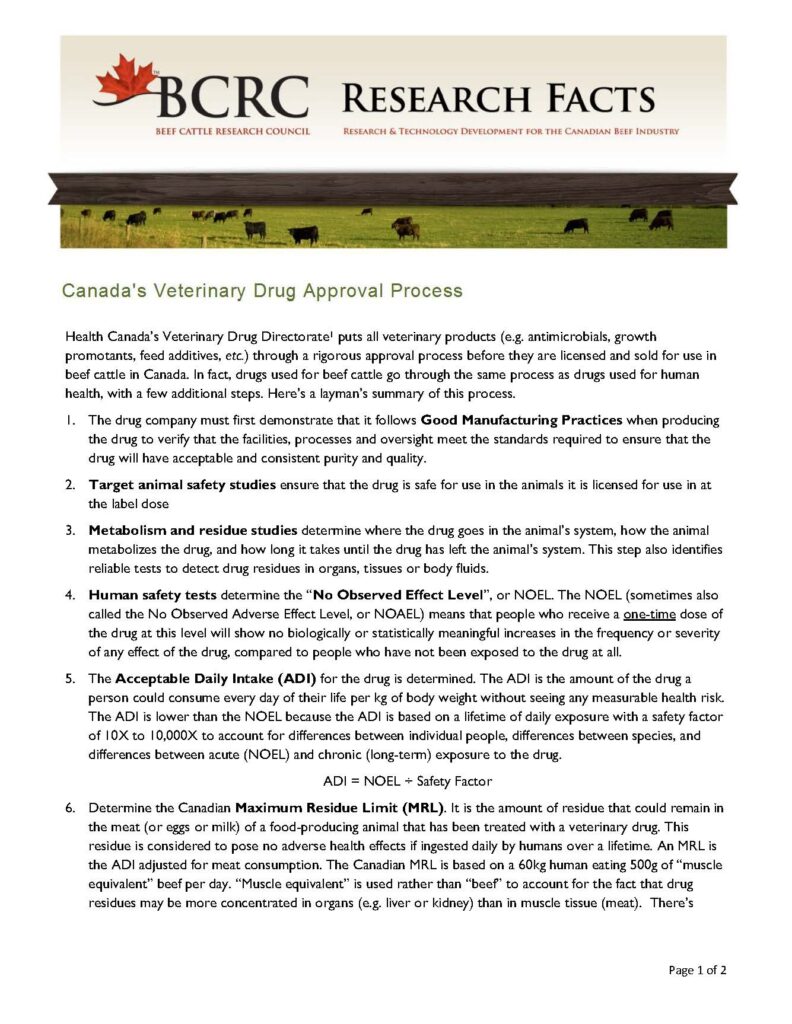Canada’s Veterinary Drug Approval Process
Health Canada’s Veterinary Drug Directorate1 puts all veterinary products (e.g. antimicrobials, growth promotants, feed additives, etc.) through a rigorous approval process before they are licensed and sold for use in beef cattle in Canada. In fact, drugs used for beef cattle go through the same process as drugs used for human health, with a few additional steps. Here’s a layman’s summary of this process.

1. The drug company must first demonstrate that it follows Good Manufacturing Practices when producing the drug to verify that the facilities, processes and oversight meet the standards required to ensure that the drug will have acceptable and consistent purity and quality.
2. Target animal safety studies ensure that the drug is safe for use in the animals it is licensed for use in at the label dose.
3. Metabolism and residue studies determine where the drug goes in the animal’s system, how the animal metabolizes the drug, and how long it takes until the drug has left the animal’s system. This step also identifies reliable tests to detect drug residues in organs, tissues or body fluids.
4. Human safety tests determine the “No Observed Effect Level”, or NOEL. The NOEL (sometimes also called the No Observed Adverse Effect Level, or NOAEL) means that people who receive a one-time dose of the drug at this level will show no biologically or statistically meaningful increases in the frequency or severity of any effect of the drug, compared to people who have not been exposed to the drug at all.
5. The Acceptable Daily Intake (ADI) for the drug is determined. The ADI is the amount of the drug a person could consume every day of their life per kg of body weight without seeing any measurable health risk. The ADI is lower than the NOEL because the ADI is based on a lifetime of daily exposure with a safety factor of 10 X to 10,000 X to account for differences between individual people, differences between species, and differences between acute (NOEL) and chronic (long-term) exposure to the drug.
ADI = NOEL ÷ Safety Factor
6. Determine the Canadian Maximum Residue Limit (MRL). It is the amount of residue that could remain in the meat (or eggs or milk) of a food-producing animal that has been treated with a veterinary drug. This residue is considered to pose no adverse health effects if ingested daily by humans over a lifetime. An MRL is the ADI adjusted for meat consumption. The Canadian MRL is based on a 60kg human eating 500g of “muscle equivalent” beef per day. “Muscle equivalent” is used rather than “beef” to account for the fact that drug residues may be more concentrated in organs (e.g. liver or kidney) than in muscle tissue (meat). There’s another hidden safety factor here, because it assumes that the average Canadian eats more than six-and-a-half 75g servings of lean beef per day; the average Canadian really consumes one serving of red meat daily2.
The MRL is calculated by multiplying the ADI by 60kg (the presumed average weight of a Canadian) divided by 500 grams (muscle equivalent)
MRL= (ADI x 60kg) ÷ 500g
Different countries may have different MRL’s because they calculate MRL using different consumption factors. For example, MRLs in the US are sometimes higher than in Canada because they are based on people consuming 300g of beef muscle equivalent daily (rather than 500g in Canada).
7. The pre-slaughter Withdrawal Time for the drug is determined from the residue depletion data (step 3, above) and the MRL. The residue depletion data is used to determine how many days it takes after the drug is administered for drug levels in the animal’s tissues to drop below the MRL. Another 48 hours is tacked on for good measure before the animal can be slaughtered.
8. Finally, the Veterinary Drug Directorate has to also consider whether the drug actually works… does the drug improve animal health, growth rate, or efficiency?
Health Canada’s Veterinary Drug Directorate must be satisfied that each of these requirements has been met before the drug is registered, licensed, assigned a Drug Identification Number and approved for use in Canada.
2. http://health.beefinfo.org/en/nc/beef_consumption/default.aspx
Learn more
Q&A on conventional production of Canadian beef
BCRC Blog | September 26, 2013
Click here to subscribe to the BCRC Blog and receive email notifications when new content is posted.
The sharing or reprinting of BCRC Blog articles is welcome and encouraged. Please provide acknowledgement to the Beef Cattle Research Council, list the website address, www.BeefResearch.ca, and let us know you chose to share the article by emailing us at info@beefresearch.ca.
We welcome your questions, comments and suggestions. Contact us directly or generate public discussion by posting your thoughts below.